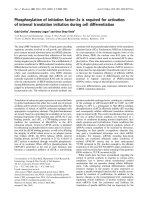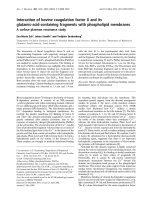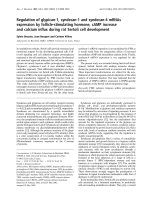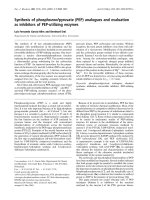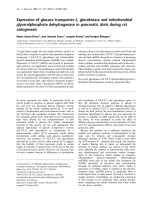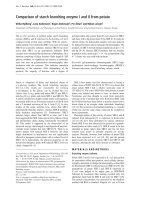Báo cáo y học: "Mechanisms of quadriceps muscle weakness in knee joint osteoarthritis: the effects of prolonged vibration on torque and muscle activation in osteoarthritic and healthy control subjects" pps
Bạn đang xem bản rút gọn của tài liệu. Xem và tải ngay bản đầy đủ của tài liệu tại đây (501.45 KB, 36 trang )
This Provisional PDF corresponds to the article as it appeared upon acceptance. Copyedited and
fully formatted PDF and full text (HTML) versions will be made available soon.
Mechanisms of quadriceps muscle weakness in knee joint osteoarthritis: the
effects of prolonged vibration on torque and muscle activation in osteoarthritic
and healthy control subjects
Arthritis Research & Therapy 2011, 13:R151 doi:10.1186/ar3467
David A Rice ()
Peter J McNair ()
Gwyn N Lewis ()
ISSN 1478-6354
Article type Research article
Submission date 15 April 2011
Acceptance date 20 September 2011
Publication date 20 September 2011
Article URL />This peer-reviewed article was published immediately upon acceptance. It can be downloaded,
printed and distributed freely for any purposes (see copyright notice below).
Articles in Arthritis Research & Therapy are listed in PubMed and archived at PubMed Central.
For information about publishing your research in Arthritis Research & Therapy go to
/>Arthritis Research & Therapy
© 2011 Rice et al. ; licensee BioMed Central Ltd.
This is an open access article distributed under the terms of the Creative Commons Attribution License ( />which permits unrestricted use, distribution, and reproduction in any medium, provided the original work is properly cited.
Mechanisms of quadriceps muscle weakness in knee joint osteoarthritis: the
effects of prolonged vibration on torque and muscle activation in osteoarthritic
and healthy control subjects
David A Rice
#
, Peter J McNair and Gwyn N Lewis.
Health and Rehabilitation Research Institute, AUT University, 90 Akoranga Drive,
Northcote, 0627, Auckland, New Zealand.
#
Corresponding author:
Abstract
Introduction:
A consequence of knee joint osteoarthritis (OA) is an inability to fully activate the
quadriceps muscles, a problem termed arthrogenic muscle inhibition (AMI). AMI
leads to marked quadriceps weakness that impairs physical function and may hasten
disease progression. The purpose of this study was to determine whether gamma-
loop (γ-loop) dysfunction contributes to AMI in people with knee joint OA.
Methods:
Fifteen subjects with knee joint OA and fifteen controls with no history of knee joint
pathology participated in this study. Quadriceps and hamstring peak isometric torque
(Nm) and electromyography (EMG) amplitude were collected before and after 20
minutes of 50Hz vibration applied to the infrapatellar tendon. Between-group
differences in pre-vibration torque were analysed using a one-way analysis of
covariance (ANCOVA), with age, gender and body mass (kg) as the covariates. If
the γ-loop is intact, vibration should decrease torque and EMG levels in the target
muscle. If dysfunctional, then torque and EMG levels should not change following
vibration. Thus, one sample t-tests were undertaken to analyse whether percent
changes in torque and EMG differed from zero after vibration in each group. In
addition, ANCOVAs were utilised to analyse between-group differences in the
percent changes in torque and EMG following vibration.
Results:
Pre-vibration quadriceps torque was significantly lower in the OA group compared to
the control group (P = 0.005). Following tendon vibration, quadriceps torque (P
<0.001) and EMG amplitude (P ≤0.001) decreased significantly in the control group
but did not change in the OA group (all P >0.299). Hamstrings torque and EMG
amplitude were unchanged in both groups (all P >0.204). The vibration induced
change in quadriceps torque and EMG were significantly different between the OA
and control groups (all P <0.011). No between-group differences were observed for
the change in hamstrings torque or EMG (all P >0.554).
Conclusions:
γ-loop dysfunction may contribute to AMI in individuals with knee joint OA, partially
explaining the marked quadriceps weakness and atrophy that is often observed in
this population.
{Keywords: Quadriceps; muscle inhibition; gamma; osteoarthritis; knee joint;
afferent}
Introduction
Individuals with osteoarthritis (OA) of the knee joint commonly display marked
weakness of the quadricep muscles, with strength deficits of 20-45% compared to
age and gender matched controls [1-3]. Persistent quadriceps weakness is clinically
important in individuals with OA as it is associated with impaired dynamic knee
stability [4] and physical function [2, 3, 5]. Moreover, the quadriceps have an
important protective function at the knee joint, work eccentrically during the early
stance phase of gait to “cushion” the knee joint and acting to decelerate the limb
prior to heel strike, reducing impulsive loading [6, 7]. Weaker quadriceps have been
associated with an increased rate of loading at the knee joint [7, 8] and recent
longitudinal data has shown that greater baseline quadriceps strength may protect
against incident knee pain [9, 10], patellofemoral cartilage loss [9] and tibiofemoral
joint space narrowing [11].
There are many of causes of quadriceps weakness in OA patients, some of which
are not fully understood. However, an important determinant of this weakness is
arthrogenic muscle inhibition (AMI) – an ongoing neural inhibition that prevents the
quadriceps muscles from being fully activated [12-14]. As well as being a direct
cause of quadriceps weakness [13], AMI may contribute to muscle atrophy [15] and
in more severe cases, can prevent effective quadriceps strengthening [16-18]. There
are several lines of evidence to suggest that AMI is caused by a change in the
discharge of sensory receptors from the damaged knee joint [14, 15, 19]. In turn, a
change in afferent discharge may alter the excitability of multiple spinal reflex and
supraspinal pathways that combine to limit activation of the quadriceps α-
motoneuron pool (for review see [14]). A strong increase in knee joint
mechanoreceptor and/or nociceptor discharge (as with acute swelling, pain or
inflammation) leads to marked quadriceps AMI [20-22]. However, some patients with
knee joint pathology continue to display striking quadriceps activation deficits in the
absence of pain and clinically detectable effusion [19, 23, 24]. Furthermore, there is
evidence from animal studies that different populations of knee joint
mechanoreceptors have opposing effects on quadriceps α-motoneuron pool
excitability and that in the normal, uninjured knee the net effect may be excitatory
[25-27]. Thus, it is possible that a loss of normal sensory output from a population of
excitatory knee joint mechanoreceptors may also contribute to AMI.
One of the neural pathways thought to be involved in mediating AMI is the γ-loop
(Figure 1). The γ-loop is a spinal reflex circuit formed by γ-motoneurons innervating
muscle spindles that in turn transmit excitatory impulses to the homonymous α-
motoneuron pool via Ia afferent nerve fibres.
Hagbarth and colleagues [28] were the first to demonstrate that excitatory input from
Ia afferents is necessary to achieve full muscle activation. These authors showed
that preferential anaesthetic block of γ-efferents reduced the firing rate of tibialis
anterior motor units during subsequent maximum effort voluntary contractions
(MVCs). These changes could be partially reversed by experimentally enhancing
spindle discharge from the affected muscle. Further investigations into the
importance of the γ-loop have relied on prolonged vibration to experimentally
attenuate the afferent portion of the γ-loop. A vibratory stimulus, applied to the
muscle or its tendon, temporarily dampens transmission in Ia afferent fibres by
increasing presynaptic inhibition, raising the activation threshold of Ia fibres and/or
causing neurotransmitter depletion at the Ia afferent terminal ending [29]. In healthy
subjects, prolonged vibration (20-30 minutes) causes a reduction in muscle force
output [30-33], EMG activity [30, 32, 33] and motor unit firing rates [30] during
subsequent MVCs. However, in people who have ruptured their anterior cruciate
ligament (ACL), prolonged vibration has no effect on quadriceps muscle activation,
[32]. Similar observations have since been confirmed up to 20 months after ACL
reconstruction [34-36]. These findings suggest that ACL rupture causes an
impairment in normal Ia afferent feedback (termed γ-loop dysfunction) that limits
quadriceps α-motoneuron depolarisation [32]. It is thought that γ-loop dysfunction is
caused by a loss of sensory output from damaged mechanoreceptors within the
injured knee joint [32]. Given the notable tissue degeneration present in osteoarthritic
knees, a loss of sensory output from a portion of knee joint mechanoreceptors
seems likely. Thus, the purpose of the current study was to determine if quadriceps
γ-loop dysfunction is also present in individuals with knee joint OA.
Materials and methods
Subjects
Fifteen subjects with OA of the knee joint (Kellgren Lawrence Score ≥ 2) and fifteen
control subjects with no history of knee injury or pathology volunteered to participate
in this laboratory based study. Subjects from both groups responded to an
advertisement requesting volunteers for research examining muscle weakness in
people with knee joint OA. All volunteers in the patient group had ongoing knee pain
and had previously been diagnosed with OA by their General Practioner. We did not
attempt to match OA subjects to control subjects on a case by case basis. However,
the control subjects were selected so that the two groups were similar in terms of
age and gender (see Table 1). Volunteers in both groups were excluded if they had a
previous history of lower limb or spinal surgery, back pain in the last 6 months with
associated neurological signs or symptoms or any pathology that precluded their
participation in maximum effort strength testing. Subjects provided written informed
consent for all experimental procedures. Ethical approval for this study was granted
by the Auckland University of Technology Ethics Committee (Auckland, New
Zealand) in accordance with the principles set out in the declaration of Helsinki.
Radiographic assessment
Subjects in the OA group were required to have a radiograph of the affected knee
joint within 2 weeks of testing. Weight-bearing, fixed flexion radiographs of the knee
were taken in the posteroanterior and lateral views [37] and scored by a single
radiologist according to the Kellgren Lawrence scale [38]. Only subjects with a
Kellgren Lawrence Score ≥ 2 were included in the study.
Experimental setup
All subjects performed a standardised, 5 minute warm-up on an exercycle.
Thereafter, subjects were seated in a custom designed chair with the hips and knees
flexed to 90°. Straps were firmly secured over the distal third of the thigh and across
the chest to limit extraneous movement. A rigid strap was secured around the ankle,
slightly superior to the malleoli. This was coupled to a metal attachment that was
connected in series to a uniaxial load cell (Precision Transducers, Auckland, New
Zealand), aligned horizontally with the ankle joint.
Quadriceps and hamstrings maximum voluntary isometric contractions
Strength testing procedures were undertaken in the (most) affected limb of the OA
subjects and the matched limb (dominant/non-dominant) of the healthy controls. All
subjects were asked to perform maximum voluntary isometric contractions (MVCs) of
their quadriceps and hamstrings muscles by pushing or pulling as hard as possible
against the ankle strap. Prior to maximum effort contractions, a series of 4
submaximal quadriceps and 4 submaximal hamstrings contractions (25%, 50%, 50%
and 75% of perceived maximum effort) were performed, with a 1 minute rest given
between each contraction. Thereafter, a 2 minute rest was given before a set of
three (6 second) quadriceps MVCs were performed followed by 3 hamstrings (6
second) MVCs. Subjects received a consistent level of verbal encouragement [39]
and were given a two minute rest period between each maximum effort contraction.
In the event that the peak force (N) produced during MVCs continued to increase
with each subsequent trial, a 4
th
and in some cases a 5
th
contraction was performed
until force plateaued or decreased. This was done in an effort to elicit a true
maximum effort from each individual. Force (N) signals were recorded from the load
cell during each contraction, where they were amplified (x100), sampled (1000 Hz)
and displayed in real-time on a computer monitor placed in front of the subject using
a customised software programme (Testpoint 7, Measurement Computing
Corporation, Norton, USA)
Surface electromyography (EMG)
During each MVC, surface EMG signals were collected from the vastus medialis
(VM), vastus lateralis (VL), semitendinosus (ST) and biceps femoris (BF) muscles.
Prior to the placement of electrodes the skin was shaved, abraded and cleaned with
alcohol to reduce signal impedance. Bipolar AgCl electrodes (Norotrode 20,
Myotronics Inc., Kent, USA) were positioned over the target muscles in accordance
with Surface Electromyography for the Non-Invasive Assessment of Muscles
(SENIAM) guidelines [40]. A ground electrode (Red Dot, 3M, St Paul, USA) was
positioned over the proximal tibia. All EMG signals were amplified (x1000), filtered
(10Hz – 1000Hz) (AMT-8, Bortec Biomedical, Alberta, Canada), and sampled at
2000Hz (Micro 1401, Cambridge Electronic Design, Cambridge, UK).
Vibration protocol
Following the initial set of quadriceps and hamstrings MVCs, subjects were asked to
relax and remained seated in the chair with their hips and knees flexed to 90°.
Vibration was then applied to the infrapatellar tendon using an electrodynamic
shaker (Ling Dynamic Systems, Herts, UK), controlled by a customised software
programme (Signal 3, Cambridge Electronic Design, Cambridge, UK) (Figure 2.).
Vibration was maintained for 20 minutes at a frequency, amplitude and force of 50
Hz, 1.5 mm and 25-30 N respectively [32, 36]. Subjects were asked to remain as still
as possible during the application of vibration. The leg was clamped in place for the
duration of the vibration period to prevent movement of the tendon relative to the
vibration probe. Immediately after vibration, subjects performed another set of at
least 3 quadriceps MVCs and 3 hamstrings MVCs, in an identical manner to that
described above. To avoid potential bias, subjects were kept unaware of the
hypothesis of the study and the purposes of the vibration until after their final post
vibration MVC. Hamstrings MVCs were included in this study to provide evidence
that our vibration protocol was specific to the quadriceps muscles and that the
vibration did not affect the activation of other muscles in the surrounding area.
Data analysis
At each measurement interval, peak isometric quadriceps and hamstrings strength
were calculated as the highest force (N) produced during any of the 3-5 MVCs
performed for each muscle group. The length of the lever arm was measured from
the lateral epicondyle of the femur to the centre of the ankle strap, which was parallel
to the load cell. Lever arm length (m) was then multiplied by peak isometric force (N)
to calculate peak torque (Nm).
Using specialised software (Signal 3, Cambridge Electronic Design, Cambridge, UK)
the root mean square (RMS) of the EMG signals from each muscle were calculated
from a one second period corresponding to the time of maximum activation for each
contraction.
Statistical analysis
To assess whether the dependent variables conformed to a normal distribution (and
thus whether parametric testing could be undertaken) Shapiro-Wilk tests were
completed. Student’s t-tests were used to analyse differences in baseline
characteristics between the OA and control groups. Between group differences in
pre-vibration quadriceps and hamstrings peak torque (Nm) were analysed using an
analysis of covariance, with body mass (kg), age and gender as the covariates [41].
If the γ-loop is intact, vibration should decrease torque and EMG levels in the target
muscle, usually by 7-15% [29, 32]. If dysfunctional, then torque and EMG levels
should not change following vibration. Thus, one sample t-tests were undertaken to
analyse whether percent changes in quadriceps and hamstrings torque and RMS
differed from zero after vibration in each group. In addition, ANCOVAs were
undertaken to analyse between group differences in the percent change in
quadriceps and hamstrings torque and RMS following vibration. The covariates were
age, gender and mass. The significance level for all statistical procedures was set to
0.05.
Results
Baseline characteristics
Baseline characteristics for each group are provided in table 1. There was no
statistically significant difference in age (p = 0.686), height (m) (p = 0.844) or mass
(kg) (p = 0.186) between groups (Table 1). Results of the Shapiro-Wilk tests
suggested that each of the dependent variables was normally distributed (all p >
0.08). Pre-vibration quadriceps peak torque was significantly lower in the OA group
(mean 121 Nm; 95% CI 95 Nm, 147 Nm) compared to the control group (mean 177
Nm; 95% CI 151 Nm, 203 Nm) (p = 0.005). While hamstrings peak torque was lower
in the OA compared to the control group, this difference did not reach statistical
significance (p = 0.101) (Figure 3).
Changes in peak torque following tendon vibration
A summary of peak torque values at each measurement interval is presented in
Table 2. Following tendon vibration, a statistically significant decrease in quadriceps
peak torque was observed in the control group (p < 0.001) but not in OA subjects (p
= 0.299) (Figure 4). The change in quadriceps torque was significantly different
between groups (p = 0.011). After vibration, the change in hamstrings peak torque
did not differ from zero in either the OA (p = 0.586) or the control group (p = 0.902)
and the change in hamstrings torque was not different between groups (p = 0.670).
Changes in Surface EMG following tendon vibration
A summary of RMS values at each measurement interval is presented in Table 2.
After vibration, a statistically significant decrease in VM RMS was observed in the
control group (p < 0.001) but not in OA subjects (p = 0.786) (Figure 5). Similarly, VL
RMS decreased after vibration in the control group (p = 0.001), but not the OA group
(p = 0.466). Significant between group differences were observed for changes in VM
RMS (p = 0.005) and VL RMS (p = 0.001). After vibration, the change in ST and BF
RMS values did not differ from zero in either the OA or control groups (all p ≥ 0.204)
and the changes did not differ between groups (both p ≥ 0.554).
Discussion
The findings of this study suggest that γ-loop dysfunction contributes to quadriceps
AMI in individuals with knee joint OA. Prolonged tendon vibration induces a
temporary γ-loop dysfunction by impairing the afferent transmission from Ia fibres to
the homonymous α-motoneuron pool [29]. The subsequent loss of excitatory sensory
input reduces α-motoneuron excitability, preventing full activation of the muscle.
Thus, a decrease in quadriceps peak torque and RMS values is expected after
vibration, as observed in the control group. In contrast, the lack of change in
quadriceps activation seen in the OA group suggests that Ia afferent transmission
may have already been impaired in these individuals, thus torque and EMG
amplitude were unaffected by vibration. This is in accordance with previous findings
from populations who had ruptured their ACL [32] or recently had an ACL
reconstruction [36, 42].
It is likely that γ-loop dysfunction occurs due to a change in sensory output from the
damaged knee joint. Studies in animals [43-45] have established that stimulation of
knee joint afferents can elicit strong reflex effects on γ-motoneurons of the muscles
surrounding the knee. Furthermore, the facilitation of extensor γ-motoneurons is
blocked when knee joint afferents are anaesthetised [43]. This has led to
suggestions that structural damage to the knee joint may simultaneously damage the
sensory receptors located in these tissues. This may reduce the output from a
population of joint afferents that in turn, diminishes quadriceps γ-motoneuron
excitability and impairs Ia afferent feedback, preventing full activation of the muscle
[19, 46]. In support of this conjecture, Konishi and colleagues [32] observed a
reduction in maximum quadriceps torque production and EMG amplitude following
the injection of 5ml of local anaesthetic into uninjured human knee joints. However,
in patients who had ruptured their ACL, anaesthetising the knee joint had no effect
on quadriceps torque and EMG [47]. Furthermore, these authors showed that
prolonged vibration failed to reduce quadriceps muscle activation in subjects with
uninjured but anaesthetised knee joints.
Thus, γ-loop dysfunction may occur due to structural changes in the OA joint such as
soft tissue degeneration of the ligaments and joint capsule [48, 49] or altered
capsular compliance [20, 50] that reduce excitatory mechanoreceptor output from
the knee joint to quadriceps γ-motoneurons. Alternatively, it has been suggested that
a reduction in neurotransmitter release at the Ia afferent terminal ending [51] or an
increase in the discharge of group IV joint afferents [45] may contribute to γ-loop
dysfunction [14]. Future studies may wish to examine these and other mechanisms
in more detail. If γ-loop dysfunction is simply caused by a loss of excitatory input
from joint afferents to quadriceps γ-motoneurons, then the afferent portion of the
pathway should be unaffected. If this is the case, short duration vibration, applied
during a strong voluntary contraction may be able to artificially restore transmission
in Ia afferents, enhancing quadriceps muscle activation [28]. A study testing this
hypothesis is currently being undertaken in our laboratory. In addition to the results
presented in the current study, quadriceps γ-loop dysfunction has been observed
after ACL injury [32, 35], ACL reconstructive surgery [36, 42] and in elderly patients
hospitalised after a fall [52]. Importantly, the mechanisms explaining γ-loop
dysfunction may be different in different populations. Obtaining a better
understanding of its underlying causes could have important implications in the
rehabilitation of these patients.
In the current study, quadriceps strength was reduced by 32% in the OA group
compared to an age and gender matched control group. This compares well to
previous studies in the literature that have observed quadriceps strength deficits of
20-45% in people with knee joint OA [1-3]. Part of this weakness is due to muscle
atrophy and part of it is due to AMI. At least in individuals with severe OA, AMI
appears to account for a greater portion of quadriceps weakness than muscle
atrophy [13]. Comparative data does not exist for individuals in earlier stages of the
disease. However, Pap et al [53] found the magnitude of quadriceps AMI to be
slightly higher in OA patients with moderate joint degeneration compared to those
with more severe and widespread joint damage. Furthermore, it should be
considered that an inability to fully activate the muscle is likely to contribute to a
portion of the atrophy anyway [15, 19]. Thus, AMI may have direct and indirect
effects on quadriceps muscle weakness.
While prolonged vibration is a useful neurophysiological tool to explore the function
of the γ-loop, it does not allow us to accurately determine the contribution of γ-loop
dysfunction to the overall magnitude of AMI, or quadriceps weakness. AMI can be
severe in individuals with knee OA, with quadriceps voluntary activation deficits of
25-35% observed [2, 46, 54]. While the ~8% reduction in post-vibration quadriceps
torque seen in the control group may suggest that the γ-loop makes a relatively small
contribution to the overall level of AMI, this is not necessarily true. Microneurography
studies have demonstrated that in relaxed muscles, the firing rate of most Ia afferent
fibres is depressed following vibration and the spindle response to stretch is reduced
by ~25% [55]. Furthermore, Hoffman reflex amplitude, which is partly determined by
Ia afferent transmission, is reduced by ~30-40% following prolonged vibration [56].
However, we cannot be sure what portion of the Ia afferent drive is impaired in
pathological populations with γ-loop dysfunction. We can simply observe that
prolonged vibration has no additional effect on OA subjects’ ability to activate their
quadriceps, which suggests that these individuals have a pre-existing impairment in
Ia afferent drive that is at least at the same level as that produced by 20 minutes of
vibration. For example, it may be that ~30% of the effective Ia afferent drive is
impaired by prolonged vibration but that in OA subjects with γ-loop dysfunction,
~80% of the effective Ia afferent drive is impaired. In this case, prolonged vibration
may have no additional effect on quadriceps activation in OA subjects but neither
would the change in quadriceps activation observed in healthy controls represent the
true effect of γ-loop dysfunction on quadriceps activation in a pathological population
(which would be greater). Furthermore, as AMI is caused by activity in multiple
inhibitory pathways [57], the influence of γ-loop dysfunction may be underestimated
in individuals with OA. This is due to spatial facilitation and the all-or-nothing nature
of α-motoneuron depolarisation. While firing of a discrete number of α-motoneurons
may be completely prevented by a given inhibitory input, others will only be partially
inhibited and are still able to depolarise [58]. However, when two (or more) forms of
inhibitory/disfacilitatory input are present, the partial inhibition produced by each
input is often sufficient to prevent depolarisation of a greater number of α-
motoneurons, so that the total inhibition is greater than the algebraic sum of the
individual inhibitory/disfacilitatory inputs [59]. In this way, even if prolonged vibration
exactly mimicked the loss of Ia afferent drive produced by γ-loop dysfunction, the
effects of γ-loop dysfunction on quadriceps activation may be far greater in a
pathological population than the effects of prolonged vibration on quadriceps
activation in healthy controls.
A limitation of the current study is that we did not confirm the presence of a
quadriceps activation deficit in the OA group using techniques such as burst
superimposition or interpolated twitch. As such, it could be argued that despite
evidence of γ-loop dysfunction, the OA subjects in this study may have learnt to fully
activate their quadriceps in the absence of full excitatory input from Ia afferents.
While this is theoretically possible, we consider it unlikely. The majority of studies
that have assessed quadriceps activation in people with knee joint OA have found
clear evidence of AMI [60]. Those where quadriceps activation deficits are equivocal
[41, 61-65] all used burst superimposition to calculate quadriceps central activation
ratios. The central activation ratio has consistently been shown to overestimate
quadriceps activation compared to interpolated twitch [66-69], while even
interpolated twitch has been suggested to overestimate true muscle activation [70],
(thus underestimating AMI).
Conclusions
The results of this study suggest that γ-loop dysfunction contributes to quadriceps
AMI in individuals with knee joint OA. The subsequent loss of Ia afferent feedback
during strong voluntary contractions may partially explain the marked quadriceps
weakness and atrophy that is often observed in this population. Quadriceps
weakness is clinically important in individuals with OA as it associated with physical
disability [2-5], an increased rate of loading [7, 8] and has been identified as a risk
factor for the initiation and progression of joint degeneration [9-11]. Future research
should aim to gain a better understanding the mechanisms underlying γ-loop
dysfunction and explore how these may differ across pathologies.
Abbreviations
ACL: anterior cruciate ligament; AMI: arthrogenic muscle inhibition; ANCOVA:
analysis of covariance; BF: biceps femoris; EMG: electromyography; MVC:
maximum effort voluntary contraction; OA: osteoarthritis; RMS: root mean square;
ST: semitendinosus; VL: vastus lateralis; VM: vastus medialis.
Competing interests
The authors declare that they have no competing interests.
Authors’ contributions
DR was involved in the conception and design of the study, collection, analysis and
interpretation of the data and the drafting and revision of the manuscript. PM was
involved in the conception and design of the study, analysis and interpretation of the
data and in the revision of the manuscript. GL was involved in the conception and
design of the study, collection and interpretation of the data and in the revision of the
manuscript. All the authors have read and approved this manuscript for publication.
Acknowledgements
Funding is gratefully acknowledged from the Accident Compensation Corporation
and Health Research Council of New Zealand who provided financial support in the
form of a PhD Career Development Award for Mr Rice. The sponsors had no
involvement in the study design, analysis, interpretation of results, writing of the
manuscript or in the decision to submit the manuscript for publication.
References
1. Hall MC, Mockett SP, Doherty M: Relative impact of radiographic
osteoarthritis and pain on quadriceps strength, proprioception, static
postural sway and lower limb function. Ann Rheum Dis 2006, 65:865-870.
2. Hassan BS, Mockett S, Doherty M: Static postural sway, proprioception,
and maximal voluntary quadriceps contraction in patients with knee
osteoarthritis and normal control subjects. Ann Rheum Dis 2001, 60:612-
618.
3. Liikavainio T, Lyytinen T, Tyrvainen E, Sipila S, Arokoski JP: Physical
function and properties of quadriceps femoris muscle in men with knee
osteoarthritis. Arch Phys Med Rehabil 2008, 89:2185-2194.
4. Felson DT, Niu J, McClennan C, Sack B, Aliabadi P, Hunter DJ, Guermazi A,
Englund M: Knee buckling: prevalence, risk factors, and associated
limitations in function. Ann Intern Med 2007, 147:534-540.
5. Hurley MV, Scott DL, Rees J, Newham DJ: Sensorimotor changes and
functional performance in patients with knee osteoarthritis. Ann Rheum
Dis 1997, 56:641-648.
6. Brandt KD, Dieppe P, Radin EL: Etiopathogenesis of osteoarthritis. Rheum
Dis Clin North Am 2008, 34:531-559.
7. Jefferson RJ, Collins JJ, Whittle MW, Radin EL, O'Connor JJ: The role of the
quadriceps in controlling impulsive forces around heel strike. Proc Inst
Mech Eng H 1990, 204:21-28.
8. Mikesky AE, Meyer A, Thompson KL: Relationship between quadriceps
strength and rate of loading during gait in women. J Orthop Res 2000,
18:171-175.
9. Amin S, Baker K, Niu J, Clancy M, Goggins J, Guermazi A, Grigoryan M,
Hunter DJ, Felson DT: Quadriceps strength and the risk of cartilage loss
and symptom progression in knee osteoarthritis. Arthritis and rheumatism
2009, 60:189-198.
10. Segal NA, Torner JC, Felson D, Niu J, Sharma L, Lewis CE, Nevitt M: Effect
of thigh strength on incident radiographic and symptomatic knee
osteoarthritis in a longitudinal cohort. Arthritis and rheumatism 2009,
61:1210-1217.
11. Segal NA, Glass NA, Torner J, Yang M, Felson DT, Sharma L, Nevitt M,
Lewis CE: Quadriceps weakness predicts risk for knee joint space
narrowing in women in the MOST cohort. Osteoarthritis Cartilage 2010,
18:769-775.
12. Hurley MV: The role of muscle weakness in the pathogenesis of
osteoarthritis. Rheum Dis Clin North Am 1999, 25:283-298, vi.
13. Petterson SC, Barrance P, Buchanan T, Binder-Macleod S, Snyder-Mackler
L: Mechanisms underlying quadriceps weakness in knee osteoarthritis.
Med Sci Sports Exerc 2008, 40:422-427.
14. Rice DA, McNair PJ: Quadriceps arthrogenic muscle inhibition: neural
mechanisms and treatment perspectives. Semin Arthritis Rheum 2010,
40:250-266.
15. Young A: Current issues in arthrogenous inhibition. Ann Rheum Dis 1993,
52:829-834.
16. Hurley MV, Jones DW, Newham DJ: Arthrogenic quadriceps inhibition and
rehabilitation of patients with extensive traumatic knee injuries. Clin Sci
(Lond) 1994, 86:305-310.
17. Rossi MD, Brown LE, Whitehurst M: Early strength response of the knee
extensors during eight weeks of resistive training after unilateral total
knee arthroplasty. J Strength Cond Res 2005, 19:944-949.
18. Stevens JE, Mizner RL, Snyder-Mackler L: Quadriceps strength and
volitional activation before and after total knee arthroplasty for
osteoarthritis. J Orthop Res 2003, 21:775-779.
19. Hurley MV: The effects of joint damage on muscle function,
proprioception and rehabilitation. Man Ther 1997, 2:11-17.
20. Geborek P, Moritz U, Wollheim FA: Joint capsular stiffness in knee
arthritis. Relationship to intraarticular volume, hydrostatic pressures,
and extensor muscle function. J Rheumatol 1989, 16:1351-1358.
21. Henriksen M, Rosager S, Aaboe J, Graven-Nielsen T, Bliddal H:
Experimental knee pain reduces muscle strength. J Pain 2011, 12:460-
467.
22. Rice D, McNair PJ, Dalbeth N: Effects of cryotherapy on arthrogenic
muscle inhibition using an experimental model of knee swelling. Arthritis
and rheumatism 2009, 61:78-83.
23. Hurley MV, Jones, D. W., Wilson, D. & Newham, D. J.: Rehabilitation of
quadriceps inhibited due to isolated rupture of the anterior cruciate
ligament. Journal of Orthopaedic Rheumatology 1992, 5:145-154.
24. Newham DJ, Hurley MV, Jones DW: Ligamentous knee injuries and
muscle inhibition. Journal of Orthopaedic Rheumatology 1989, 2:163-173.
25. Baxendale RH, Ferrell WR, Wood L: The effect of mechanical stimulation
of knee joint afferents on quadriceps motor unit activity in the
decerebrate cat. Brain Res 1987, 415:353-356.
26. Baxendale RH, Ferrell WR, Wood L: Responses of quadriceps motor units
to mechanical stimulation of knee joint receptors in the decerebrate cat.
Brain Res 1988, 453:150-156.
27. Grigg P, Harrigan EP, Fogarty KE: Segmental reflexes mediated by joint
afferent neurons in cat knee. Journal of neurophysiology 1978, 41:9-14.
28. Hagbarth KE, Kunesch EJ, Nordin M, Schmidt R, Wallin EU: Gamma loop
contributing to maximal voluntary contractions in man. J Physiol 1986,
380:575-591.
29. Shinohara M: Effects of prolonged vibration on motor unit activity and
motor performance. Med Sci Sports Exerc 2005, 37:2120-2125.
30. Bongiovanni LG, Hagbarth KE, Stjernberg L: Prolonged muscle vibration
reducing motor output in maximal voluntary contractions in man. J
Physiol 1990, 423:15-26.
31. Jackson SW, Turner DL: Prolonged muscle vibration reduces maximal
voluntary knee extension performance in both the ipsilateral and the
contralateral limb in man. Eur J Appl Physiol 2003, 88:380-386.
32. Konishi Y, Fukubayashi T, Takeshita D: Possible mechanism of quadriceps
femoris weakness in patients with ruptured anterior cruciate ligament.
Med Sci Sports Exerc 2002, 34:1414-1418.
33. Kouzaki M, Shinohara M, Fukunaga T: Decrease in maximal voluntary
contraction by tonic vibration applied to a single synergist muscle in
humans. J Appl Physiol 2000, 89:1420-1424.
34. Konishi Y, Aihara Y, Sakai M, Ogawa G, Fukubayashi T: Gamma loop
dysfunction in the quadriceps femoris of patients who underwent
anterior cruciate ligament reconstruction remains bilaterally. Scand J
Med Sci Sports 2006.
35. Konishi Y, Konishi H, Fukubayashi T: Gamma loop dysfunction in
quadriceps on the contralateral side in patients with ruptured ACL. Med
Sci Sports Exerc 2003, 35:897-900.
36. Richardson MS, Cramer JT, Bemben DA, Shehab RL, Glover J, Bemben MG:
Effects of age and ACL reconstruction on quadriceps gamma loop
function. Journal of geriatric physical therapy 2006, 29:28-34.
37. Charles HC, Kraus VB, Ainslie M, Hellio Le Graverand-Gastineau MP:
Optimization of the fixed-flexion knee radiograph. Osteoarthritis Cartilage
2007, 15:1221-1224.
38. Kellgren JH, Lawrence JS: Osteo-arthrosis and disk degeneration in an
urban population. Ann Rheum Dis 1958, 17:388-397.
39. McNair PJ, Depledge J, Brettkelly M, Stanley SN: Verbal encouragement:
effects on maximum effort voluntary muscle action. Br J Sports Med
1996, 30:243-245.
40. Merletti R, Hermens H: Introduction to the special issue on the SENIAM
European Concerted Action. J Electromyogr Kinesiol 2000, 10:283-286.
41. Heiden TL, Lloyd DG, Ackland TR: Knee extension and flexion weakness
in people with knee osteoarthritis: is antagonist cocontraction a factor?
J Orthop Sports Phys Ther 2009, 39:807-815.
42. Konishi Y, Aihara Y, Sakai M, Ogawa G, Fukubayashi T: Gamma loop
dysfunction in the quadriceps femoris of patients who underwent
anterior cruciate ligament reconstruction remains bilaterally. Scand J
Med Sci Sports 2007, 17:393-399.
43. Ellaway PH, Davey NJ, Ferrell WR, Baxendale RH: The action of knee joint
afferents and the concomitant influence of cutaneous (sural) afferents
on the discharge of triceps surae gamma-motoneurones in the cat. Exp
Physiol 1996, 81:45-66.
44. Johansson H, Sjolander P, Sojka P: Actions on gamma-motoneurones
elicited by electrical stimulation of joint afferent fibres in the hind limb of
the cat. J Physiol 1986, 375:137-152.
45. Scott DT, Ferrell WR, Baxendale RH: Excitation of soleus/gastrocnemius
gamma-motoneurones by group II knee joint afferents is suppressed by
group IV joint afferents in the decerebrate, spinalized cat. Exp Physiol
1994, 79:357-364.
46. Hurley MV, Newham DJ: The influence of arthrogenous muscle inhibition
on quadriceps rehabilitation of patients with early, unilateral
osteoarthritic knees. Br J Rheumatol 1993, 32:127-131.
47. Konishi Y, Suzuki Y, Hirose N, Fukubayashi T: Effects of lidocaine into
knee on QF strength and EMG in patients with ACL lesion. Med Sci
Sports Exerc 2003, 35:1805-1808.
48. Mullaji AB, Marawar SV, Simha M, Jindal G: Cruciate ligaments in arthritic
knees: a histologic study with radiologic correlation. The Journal of
arthroplasty 2008, 23:567-572.
49. Tahmasebi-Sarvestani A, Tedman R, Goss AN: The influence of
experimentally induced osteoarthrosis on articular nerve fibers of the
sheep temporomandibular joint. J Orofac Pain 2001, 15:206-217.
50. Ferrell WR: The effect of acute joint distension on mechanoreceptor
discharge in the knee of the cat. Q J Exp Physiol 1987, 72:493-499.
51. Palmieri RM, Weltman A, Edwards JE, Tom JA, Saliba EN, Mistry DJ,
Ingersoll CD: Pre-synaptic modulation of quadriceps arthrogenic muscle
inhibition. Knee Surg Sports Traumatol Arthrosc 2005, 13:370-376.
52. Konishi Y, Kasukawa T, Tobita H, Nishino A, Konishi M: Gamma loop
dysfunction of the quadriceps femoris of elderly patients hospitalized
after fall injury. J Geriatr Phys Ther 2007, 30:54-59.
53. Pap G, Machner A, Awiszus F: Strength and voluntary activation of the
quadriceps femoris muscle at different severities of osteoarthritic knee
joint damage. J Orthop Res 2004, 22:96-103.
54. Mizner RL, Stevens JE, Snyder-Mackler L: Voluntary activation and
